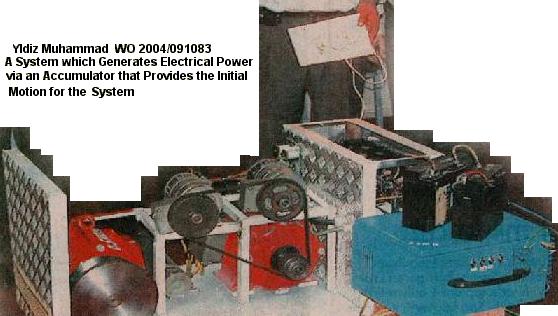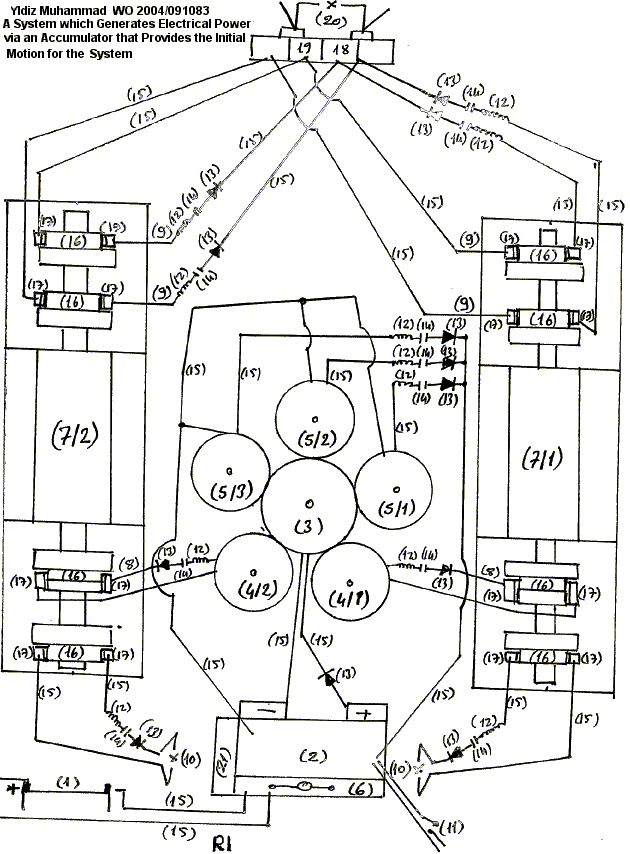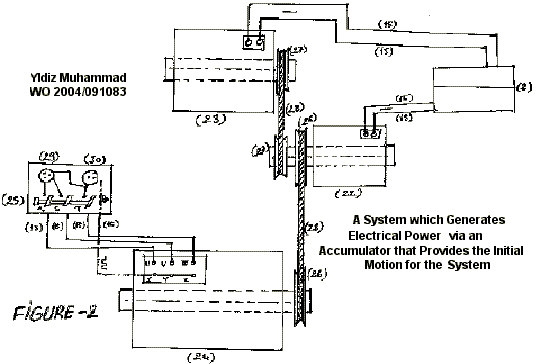##YILDIZ, Muammer: http://www.ocean-star.org/center.html
# Electrical Generator , from http://rexresearch.com/yildiz/yildiz.htm

# WO 2004/091083, A System which Generates Electrical Power via an Accumulator that Provides the Initial Motion for the System
Abstract :
This is a portable system that generates electrical power via an accumulator that provides the initial motion for the system. Two batteries are used in this system and the system is kept working via the initial motion provided by these batteries. There is no need for another transformer. This device works using its own mechanism and there is no need for additional devices. In this way, a continuous electrical power generation is possible. This device can work without connecting it to a network so it is possible to use it at places where electricity does not exist. Moreover, when connected to the entry of a building, the need for a network is avoided. This system generates electrical power independent of a network.
Description :
A system which generates electrical power via an accumulator that provides the initial motion for the system. This is a portable system that generates electrical power via an accumulator that provides the initial motion for the system. Already existing systems can generate electrical power of whose duration depends on the lifetime of the battery. In these systems, the battery has to be reloaded in order to restart the system. 12V electrical power provided by the batteries used in cars are increased to 220 V via transformers.
Two accumulators are used in out invention. The system works on a continuous basis after initial startup via these accumulators. There is no need for another transformer. Our system, which generates electrical power, does not need any other devices and it keeps on generating energy via its own mechanism. Also, the system works without connecting it to a network.
Thus, it can be used at any place where no electricity exists. Nevertheless, when this system is connected to the entry of the buildings, there is no need for an additional network. The system can produce electrical power independent of a network.
Description of the drawings:
Below are the explanations of the figures that provide a better understanding about this invention.
Figure 1 and 2 — Schematic view of the system.


Numbers on the schema: 1. — Accumulator ; 2. — Regulator ; 3. — Big gear ; 3/1 — Starter dynamo ; 4. — Small gear ; 4/1-2. — Feedback dynamo ; 5. — Small gear ; 5/1-2-3. — Feedback dynamo ; 6. —Contactor ; 7/1-2. — Commitatris [Commutator] ; 8. — 19 DC input ; 9. — 24 DC input ; 10. — 580 DC output ; 11. — Switch ; 12. — Shunt ; 13. — Rectifier ; 14. — Capacitor ; 15. — 2.5 mm cable ; 16. — Collctor ; 17. — Charcoal [Carbon] ; 18. — Fixing clamps (+) ; 19. — Fixing clamps (-) ; 20. — Lamp ; 21. — Conjector ; 22. — Starter dynamo ; 23. — Feedback dynamo ; 24. — AC dynamo ; 25. — Magnetic switch ; 26. — Pulley ; 27. — Pulley ; 28. — V pulley ; 29. — 380 V current output ; 30. — 220 V current output
Description:
This invention is a system that starts working via the motion of alternator. There exist two accumulators (1), and the first motion provided by the accumulator is carried to the regulator. Contractor (6) keeps the starter dynamo working by disconnecting the accumulator (1) once the regulator (2) is put in. The voltage coming from the accumulator (1) passes through the regulator and the start dynamo (3/1) starts working and thus the feedback alternators via the gears ( 4/1-2 5/1-23-3 ). Feedback dynamo starts sending pure DC current to regulator via shunt (12), capacitor (14) and diode (13). It connects all the current that reaches to the regulator in 4 seconds and sends to the contactor (6). Accumulator (1) is put out by this current that reaches to the regulator. This current is transformed to the started dynamo (3/1). There becomes a transformation within the system. In case of electricity shortage, it keeps on working by using the current generated by the commitatris (7/1).
Via the starter dynamo (3/1), DC is generated in the alternators which are connected to the gears and this current is transformed to the commitatris (7/1-2) and DC voltage is generated at commitatris (7/1-2).
Second System :
3 x 24 DC voltage is transformed to the second starter dynamo (22). Once the start dynamo works (22), a feedback dynamo (23) having a pulley system and a feedback dynamo (24) generating alternative current starts working. The feedback dynamo (23) starts feeding back; the feedback dynamo (24) which generates AC is independently generating 6 KV, 18 Amp, 50 Hz current. Moreover, first system produces 24 DC and 580 DC current on its own.
The bigger the gears are, the more current is generated.
This system, which is subject to our invention, can be used at any place. You can use it at places where there exists no electricity, or at places such as villages, cities, buildings, greenhouses where there is not network. Moreover, network is no more a must. Instead of a network, you can use our system. There is no need for gasoline when this system is used in vehicles.
Claims:
1 – This is a system where the initial motion is provided by an accumulator and the following items constitute the system: two accumulators (1) that provide the initial motion for the system, a regulator (2) and a starter dynamo (3/1), three feedback dynamos (5/1-2-3) connected to the gears of the starter dynamo, two alternator dynamos (4/1-2) which are connected to the gears of the starter dynamo and also two commitatris (2/1-2) working via the generated energy and also a feedback dynamo (23) and alternating current dynamo (24), as the second system, that works via the voltage generated by the first system.
2 – It is the system mentioned in the first claim and it is related to the feature that the first motion is provided from the accumulators to the regulator (2) and the start dynamo (3) and the commitatris (7/1-2) start working feedback dynamo (23) and alternators (4/1-2) and the voltage enters the regulator and puts out the accumulator (1) via contactor (6).
3 – It is the system mentioned in the first claim and it is related to the feature that the accumulator can be reloaded by the help of connector when needed.
4 – It is the system mentioned in the first claim and it is related to the feature that it can be used either as direct current or as alternating current.
5 – It is the system mentioned in the first claim and it is related to the feature that the regulator regulates both the voltage of the first system and the second system and provides two main networks tht provide the needed electricity.
# Technische Universiteit Eindhoven [Eindhoven Technical University] ; Department of Electrical Engineering, Electromechanics and Power ; EUT_JD2005_2.doc (7-28-2005)
Experiments on an Apparatus Intended to Generate Electricity without Physical Connections to Other Power Sources , byJ.J. Duarte
This technical note aims at describing a test I personally conducted in Izmir, Turkey on July 17, 2005. The purpose of the experiment was to check the energy balance with respect to input and output of an apparatus, which was the embodiment of the invention described in international patent WO 2004/091083 A1.
The apparatus was confined inside a metallic box, and I was allowed to inspect everything outside this box. However, in order to protect the core ideas of the invention, I was not supposed to check all the details of the internal parts. According to the inventor the apparatus is predominantly a mechanical system, without any kind of energy storage inside the box like batteries, accumulators, flywheels, combustion motors, chemical or radioactive reactions. I believe the intentions of the inventor were in good faith.
The experimental setup was quite simple, as shown schematically in Figure 1. It consisted of placing the box with unknown contents, from which DC voltages and currents were expected to be generated, on a table in the middle of a room. From the box, a cable with two terminal contacts was available for connecting electrical loads. I placed measurement instruments between the box output terminals and the load. The load consisted of an ordinary AC-DC inverter, this inverter being connected to an incandescent lamp. The working principle of the inverter and the lamp type were not relevant for analyzing the results, because the output power delivered by the box was measured immediately after the output terminals. Photographs of the setup are included in Appendix A.
Figure 1: Experimental Setup

After a short start procedure, the metallic box together with the lead were fully isolated from the environment (in what concerns other physical contacts like cable connections to the public mains) during the whole duration of the measurements. This situation is in agreement with the description given in the international patent [ WO 2004/091-83 ] mentioned above. Since the energy input entering the apparatus was quite modest, as it will become clear further in this note, the main issue was then to measure the delivered energy output. I had prepared the power measurements with care, by using reliable instruments I personally brought with me from my own university laboratory. In order to measure the DC voltage directly out of the positive and the negative electrical terminals I used two different voltmeters in parallel, one analog (constructed with permanent magnets and wires) and another digital (that employs electronic circuits to acquire and to display the measured values). These instruments are based on completely different working principles. Also for measuring the DC current coming out the positive terminal and entering back into the negative terminal, I placed two ammeters in series, again one analog and the other digital. If electromagnetic waves would interfere with the measurements, they would disturb one or the other instrument, but not all four pieces at the same time in the same way. Before starting the experiment, no kind of audible noise was being produced by the apparatus. Also, I measured the voltage differences between the internal and external connection points, and no potential differences between the internal and external connection points, and no potentials were found. So far as I could observe, the apparatus was completely at rest. The start procedure consisted of connecting a small 12V DC lead-acid accumulator to two contact points inside the box, during a short time interval (see Figure B1 in Appendix B). I observed this time interval with the help of my own watch, and it was more than 5 seconds, but less than 10 seconds. In later calculations it is reasonable to consider this start time interval as being equal to 8 seconds. After that, no other energy input was connected to the box by means of cables. Immediately after the start procedure I could hear noise as produced by rotating parts inside the box. The inventor communicated that a stabilizing time interval of about 10 minutes should be respected before switching on the load (inverter plus lamp). During this interval it was possible to observe in both voltmeters that DC voltage was being generated on the terminals, which decayed slowly from 12.9 V DC to 12.5 V DC. The displayed values in the analog and digital instruments were in good match. After 10 minutes I switched on the DC inverter. In the following hours I observed and registered by hand the values of voltages and currents displayed by the instruments. The displayed values were quite stable; therefore I decided to register them first after 15 minutes, later at each half hour. From time to time I sensed the internal parts in the box with my hands, looking for temperature gradients, but I could not perceive any noticeable temperature rise with respect to the ambient. After 5 hours I took the decision to stop the measurements. Results are given in Table 1. The displayed values of both voltmeters and both ammeters were in good agreement (in view of the precision of the instruments), as it can be seen in Table 1. For this reason, I dare to conclude that the results Ive registered are reliable, to the best of my knowledge. From Table 1 it is possible to see that the generated output voltage and current remained fairly constant during the 5 hours test.
…
Remarks:
So far the experiment has been described. The following comments are my own subjective interpretation.
Power calculations based on the registered values of voltages and currents in Table 1 lead to the conclusion that much more energy is delivered by the box, which was completely isolated from the environment, than the possible initial energy input used to start the process. For instance, the energy output after 5 hours is approximately given by
( 12.25 V ) x ( 2.3 A ) x ( 5 x 60 x 60 s ) = 507 kJ
Therefore, in order to input this same amount of energy into the box during the start procedure, the current that would have been drawn from the small 12 V lead-acid accumulator for the duration of 8 seconds is found to be
507 kJ / ( 12 V ) x ( 8 s ) = 5280 A
which is physically not possible to realize considering the volume of the accumulator and the simple connector contacts shown in Appendix B!
Considering the inventors assurance that the apparatus is mainly a mechanical device, and that no kind of energy storage was implemented inside the box, it isnt clear where the measured excess of energy out of the box is coming from — whether out of electromagnetic fields or as the result of some anomaly associated with rotating bodies in terms of inertia. This is a most interesting phenomenon, which deserves further attention.
After analyzing the results in detail, together with the drawing and explanations provided by the inventor (see Appendix C), it was possible to recognize from the schematics certain mechanical structures, the so-called homopolar machines, turning at high speed of rotation.
This is a really exciting idea because a link could be established between the apparatus under observation and a famous experiment performed in 1831 by Michael Faraday, the inventor of the electrical machines. In the academic literature this old experiment is known as the Paradox of Faradays Disk.
Indeed, many other scientists hypothesize about the possibility of constructing homopolar machines with efficiency above 100% (see, for instance, the paper of Brice DePalma, “On the Possibility of Extraction of Electrical Energy Directly from Space” in the academic journal Speculations in Science and Technology, Sept. 1990, Vol. 13, No. 4 ) [ see also: http://www.rexresearch.com/depalma/depalma.htm ]. However, up to the present time nobody has demonstrated in a convincing way a practical application of the principle. Perhaps the inventor has discovered the missing link in these machine; who knows?
Of course, the straightforward way to check this possibility would be to inspect the contents inside the box. However, the inventor is only willing to allow that after a solid commitment with a research institution or an industrial partner.
So, the next step would be to exclude the possibility of some kind of conventional electrochemical energy processing inside the apparatus. For this purpose the realization of another experiment, similar to the one described above, would be advisable, but not without long run-time of measurements. The results should convince that, indeed, it is not possible to get the same energy output with the best commercially available battery. Therefore, a new experiment may take many days (about 4 or 5) to be executed.
Eindhoven ; 28 July 2005
# See also Patrick Kelly’ file http://panacea-bocaf.org/files/patrickkelly/D7.pdf